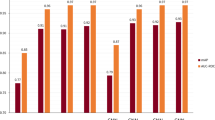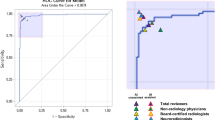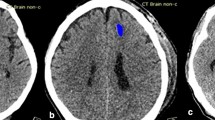Abstract
Purpose
To elucidate the effect of deep learning–based computer-assisted detection (CAD) on the performance of different-level physicians in detecting intracranial haemorrhage using CT.
Methods
A total of 40 head CT datasets (normal, 16; haemorrhagic, 24) were evaluated by 15 physicians (5 board-certificated radiologists, 5 radiology residents, and 5 medical interns). The physicians attended 2 reading sessions without and with CAD. All physicians annotated the haemorrhagic regions with a degree of confidence, and the reading time was recorded in each case. Our CAD system was developed using 433 patients’ head CT images (normal, 203; haemorrhagic, 230), and haemorrhage rates were displayed as corresponding probability heat maps using U-Net and a machine learning–based false-positive removal method. Sensitivity, specificity, accuracy, and figure of merit (FOM) were calculated based on the annotations and confidence levels.
Results
In patient-based evaluation, the mean accuracy of all physicians significantly increased from 83.7 to 89.7% (p < 0.001) after using CAD. Additionally, accuracies of board-certificated radiologists, radiology residents, and interns were 92.5, 82.5, and 76.0% without CAD and 97.5, 90.5, and 81.0% with CAD, respectively. The mean FOM of all physicians increased from 0.78 to 0.82 (p = 0.004) after using CAD. The reading time was significantly lower when CAD (43 s) was used than when it was not (68 s, p < 0.001) for all physicians.
Conclusion
The CAD system developed using deep learning significantly improved the diagnostic performance and reduced the reading time among all physicians in detecting intracranial haemorrhage.






Similar content being viewed by others
Abbreviations
- CT:
-
Computed tomography
- AUC:
-
Area under the curve
- CAD:
-
Computer-assisted detection
- DL:
-
Deep learning;
- FOM:
-
Figure of merit
- ICH:
-
Intracranial haemorrhage
- MRMC ROC:
-
Multi-reader, multi-case study of receiver operating characteristics
- PACS:
-
Picture archiving and communication systems
References
Hemphill JC 3rd, Greenberg SM, Anderson CS, Becker K, Bendok BR, Cushman M, Fung GL, Goldstein JN, Macdonald RL, Mitchell PH, Scott PA, Selim MH, Woo D (2015) Guidelines for the management of spontaneous intracerebral hemorrhage: a guideline for healthcare professionals from the American Heart Association/American Stroke Association. Stroke 46(7):2032–2060
Saad AF, Chaudhari R, Fischbein NJ, Wintermark M (2018) Intracranial hemorrhage imaging. Semin Ultrasound CT MR 39(5):441–456
Takagi Y, Hadeishi H, Mineharu Y, Yoshida K, Ogasawara K, Ogawa A, Miyamoto S (2018) Initially missed or delayed diagnosis of subarachnoid hemorrhage: a nationwide survey of contributing factors and outcomes in Japan. J Stroke Cerebrovasc Dis 27(4):871–877
Strub WM, Leach JL, Tomsick T, Vagal A (2007) Overnight preliminary head CT interpretations provided by residents: locations of misidentified intracranial hemorrhage. AJNR Am J Neuroradiol 28(9):1679–1682
Gulshan V, Peng L, Coram M, Stumpe MC, Wu D, Narayanaswamy A, Venugopalan S, Widner K, Madams T, Cuadros J, Kim R, Raman R, Nelson PC, Mega JL, Webster DR (2016) Development and validation of a deep learning algorithm for detection of diabetic retinopathy in retinal fundus photographs. JAMA 316(22):2402–2410
Esteva A, Kuprel B, Novoa RA, Ko J, Swetter SM, Blau HM, Thrun S (2017) Dermatologist-level classification of skin cancer with deep neural networks. Nature 542(7639):115–118
Nakata N (2019) Recent technical development of artificial intelligence for diagnostic medical imaging. Jpn J Radiol 37(2):103–108
Chang PD, Kuoy E, Grinband J, Weinberg BD, Thompson M, Homo R, Chen J, Abcede H, Shafie M, Sugrue L, Filippi CG, Su MY, Yu W, Hess C, Chow D (2018) Hybrid 3D/2D convolutional neural network for hemorrhage evaluation on head CT. AJNR Am J Neuroradiol 39(9):1609–1616
Chilamkurthy S, Ghosh R, Tanamala S, Biviji M, Campeau NG, Venugopal VK, Mahajan V, Rao P, Warier P (2018) Deep learning algorithms for detection of critical findings in head CT scans: a retrospective study. Lancet 392(10162):2388–2396
Chan T, Huang HK (2008) Effect of a computer-aided diagnosis system on clinicians' performance in detection of small acute intracranial hemorrhage on computed tomography. Acad Radiol 15(3):290–299
Ueda D, Yamamoto A, Nishimori M, Shimono T, Doishita S, Shimazaki A, Katayama Y, Fukumoto S, Choppin A, Shimahara Y, Miki Y (2019) Deep learning for MR angiography: automated detection of cerebral aneurysms. Radiology 290(1):187–194
Park A, Chute C, Rajpurkar P, Lou J, Ball RL, Shpanskaya K, Jabarkheel R, Kim LH, McKenna E, Tseng J, Ni J, Wishah F, Wittber F, Hong DS, Wilson TJ, Halabi S, Basu S, Patel BN, Lungren MP, Ng AY, Yeom KW (2019) Deep learning-assisted diagnosis of cerebral aneurysms using the HeadXNet model. JAMA Netw Open 2(6):e195600
Sohns C, Angic BC, Sossalla S, Konietschke F, Obenauer S (2010) CAD in full-field digital mammography-influence of reader experience and application of CAD on interpretation of time. Clin Imaging 34(6):418–424
Conant EF, Toledano AY, Periaswamy S, Fotin SV, Go J, Boatsman JE, Hoffmeister JW (2019) Improving accuracy and efficiency with concurrent use of artificial intelligence for digital breast tomosynthesis. Radiol Artif Intell 1(4):e180096
Yuh EL, Gean AD, Manley GT, Callen AL, Wintermark M (2008) Computer-aided assessment of head computed tomography (CT) studies in patients with suspected traumatic brain injury. J Neurotrauma 25(10):1163–1172
Chan T (2007) Computer aided detection of small acute intracranial hemorrhage on computer tomography of brain. Comput Med Imaging Graph 31(4–5):285–298
Prevedello LM, Erdal BS, Ryu JL, Little KJ, Demirer M, Qian S, White RD (2017) Automated critical test findings identification and online notification system using artificial intelligence in imaging. Radiology 285(3):923–931
Cho J, Park KS, Karki M, Lee E, Ko S, Kim JK, Lee D, Choe J, Son J, Kim M, Lee S, Lee J, Yoon C, Park S (2019) Improving sensitivity on identification and delineation of intracranial hemorrhage lesion using cascaded deep learning models. J Digit Imaging 32(3):450–461
Dawud AM, Yurtkan K, Oztoprak H (2019) Application of deep learning in neuroradiology: brain haemorrhage classification using transfer learning. Comput Intell Neurosci 2019:4629859
Ginat DT (2020) Analysis of head CT scans flagged by deep learning software for acute intracranial hemorrhage. Neuroradiology 62(3):335–340
Funding
The authors received no external funding for this study.
Author information
Authors and Affiliations
Corresponding author
Ethics declarations
Conflicts of interest
Yoshiyuki Watanabe and Osaka University received the research fund from Dai-Nippon Printing Corp. Ltd. Takahiro Tanaka and Atsushi Nishida are employees of Dai-Nippon Printing Corp. Ltd.
Ethical approval and informed consent
The ethics board of our institution comprehensively reviewed and approved the protocol of this study. Because the images had been acquired during daily routine examination, the need for informed consent was waived by the ethics board.
Additional information
Publisher’s note
Springer Nature remains neutral with regard to jurisdictional claims in published maps and institutional affiliations.
Rights and permissions
About this article
Cite this article
Watanabe, Y., Tanaka, T., Nishida, A. et al. Improvement of the diagnostic accuracy for intracranial haemorrhage using deep learning–based computer-assisted detection. Neuroradiology 63, 713–720 (2021). https://doi.org/10.1007/s00234-020-02566-x
Received:
Accepted:
Published:
Issue Date:
DOI: https://doi.org/10.1007/s00234-020-02566-x




